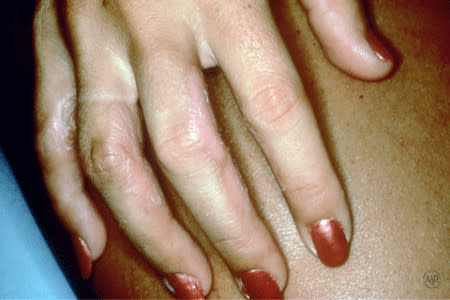How to prevent skin problems while gardening
How to prevent skin problems while gardening
Although gardening can be an enjoyable activity for many, it can take a turn for the worse if you injure yourself, come into contact with a poisonous plant, or have an allergic reaction. To prevent skin problems from gardening or yardwork, follow these tips from board-certified dermatologists.
The grass under Tim’s hedges desperately needed trimming, so one summer day he tackled the job. He never suspected that 36 hours later he’d be in the emergency room with a painful, blistering rash.
The doctor who examined him noticed that the rash appeared only on Tim’s hands, neck, and parts of his arms. Tim said that while he was trimming his grass, he was wearing a short-sleeved shirt.
After a few more questions, Tim’s doctor gave him the diagnosis — phytophotodermatitis. While the name is anything but simple, the cause is straightforward.
Tim got plant sap on his skin. When sunlight hit the sap on Tim’s bare skin, a chemical reaction occurred. This reaction causes a painful, blistering rash. It can take hours — or even a few days — for the rash to appear.
Injuries like this are more common than you may think. By taking a few precautions, you can prevent many injuries due to gardening or yardwork.
Prevent a rash while gardening
Tim could have prevented his rash by wearing gloves, a long-sleeved shirt, and sunscreen while trimming the grass.

9 ways to protect your skin while gardening
Dermatologists recommend the following while gardening:
Cover up. When working with plants, everything from the plant’s sap to its thorns or spines can injure your skin. Touching certain plants can cause an allergic skin reaction. The best way to protect yourself is to cover your skin. When working with plants, dermatologists recommend wearing:
Use sunscreen. To protect your skin from the sun, you’ll also want to apply sunscreen that offers:
Avoid gardening when the sun is strongest. The sun’s rays are strongest between 10 a.m. and 2 p.m. When possible, dermatologists recommend staying indoors during these hours.
Take precautions to avoid bug bites. You can prevent many injuries and illnesses due to bugs by:
Read labels on pest control products, plant foods, and fertilizers before using them. Many gardening products that we use from insecticides to weed killers can cause injuries ranging from a mild rash to severe burns. In rare cases, people have developed life-threatening injuries.
Protect your skin while gardening
Gloves help prevent dirt from settling in the lines of your hands, dry skin, and peeling nails.

Avoid touching your face while gardening. You could get plant sap or something else on your face, which might injure you.
Treat wounds right away. If you have a minor injury, such as a puncture wound from a thorn, it can be tempting to ignore it and keep working. Don’t. Even a minor wound can become infected.
Skip foods and drinks that contain citrus — or follow this precaution. When citrus juice gets on your skin, it can react with sunlight and can cause a blistering rash or painful swelling. Foods that contain citrus include lemons, limes, grapefruit, and oranges.
Use caution around foods and drinks that contain citrus
You can prevent the swelling and pain due to citrus juice mixing with sunlight by doing one of the following:
- Avoid citrus while outdoors
- Rinse your skin with lots of water immediately after touching anything with citrus and then apply sunscreen

Shower when you finish gardening and change into clean clothes. Sap, pollen, and other parts of plants can get on your clothes and skin. To protect your skin, shower and put on clean clothes immediately after gardening.
Prevent injuries while gardening
Wearing gloves and long sleeves help to prevent many injuries caused by gardening.

When to see a board-certified dermatologist
While many skin problems caused by gardening can be prevented, an injury can still occur. You can treat most skin injuries at home by:
Cleaning and caring for wounds right away
Treating itchy or irritated skin with a cortisone cream
Alleviating allergy symptoms, such as itchy eyes and sneezing, by taking an antihistamine
If an injury doesn’t heal or worsens, a board-certified dermatologist can help.
Related AAD resources
Images
References
Tabner A, McQueen C, et al. “Summertime and the patient is itchy.” BMJ Case Rep. 2014 Nov 19;2014.
Vaiman M, Lazarovich T, et al. “Pantoea agglomerans as an indicator of a foreign body of plant origin in cases of wound infection.” J Wound Care. 2013;22:182, 184-5.
Sakharov S, Csomor J, et al. “Toxic epidermal necrolysis after exposure to dithiocarbamate fungicide mancozeb.” Basic Clin Pharmacol Toxicol. 2016;118(1):87-91.
 Atopic dermatitis: More FDA-approved treatments
Atopic dermatitis: More FDA-approved treatments
 Biosimilars: 14 FAQs
Biosimilars: 14 FAQs
 How to trim your nails
How to trim your nails
 Relieve uncontrollably itchy skin
Relieve uncontrollably itchy skin
 Fade dark spots
Fade dark spots
 Untreatable razor bumps or acne?
Untreatable razor bumps or acne?
 Tattoo removal
Tattoo removal
 Scar treatment
Scar treatment
 Free materials to help raise skin cancer awareness
Free materials to help raise skin cancer awareness
 Dermatologist-approved lesson plans, activities you can use
Dermatologist-approved lesson plans, activities you can use
 Find a Dermatologist
Find a Dermatologist
 What is a dermatologist?
What is a dermatologist?

